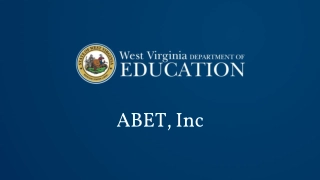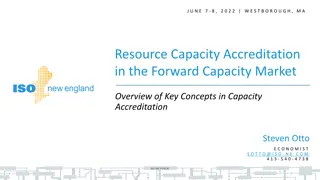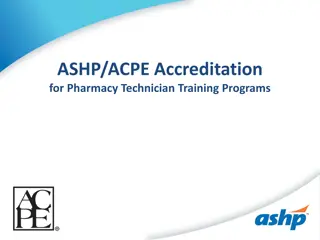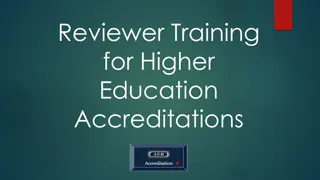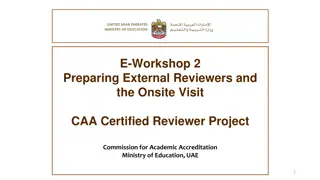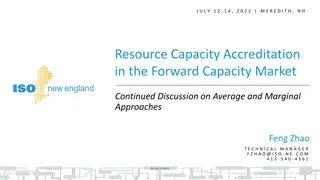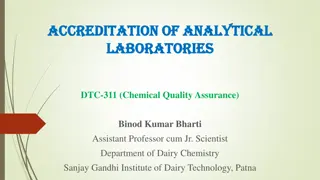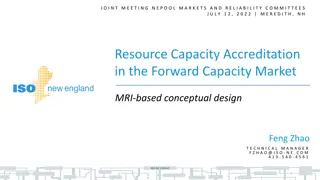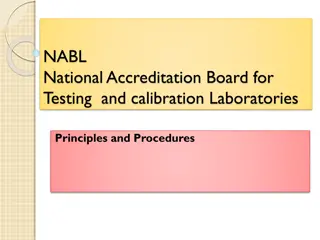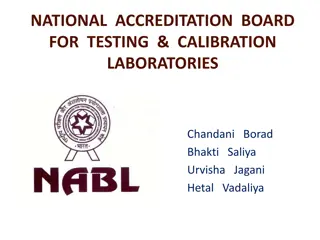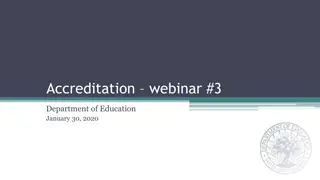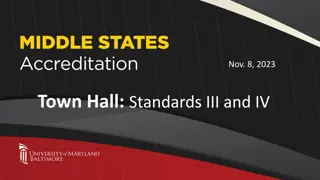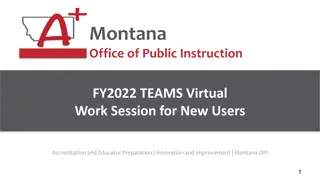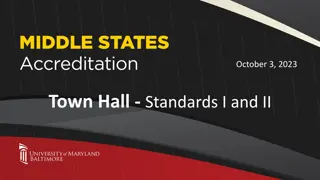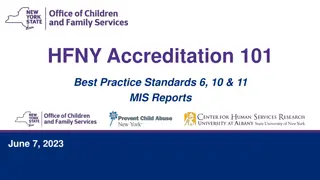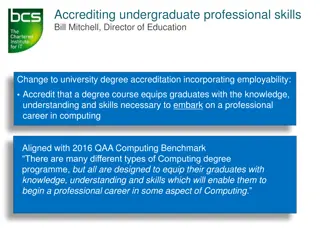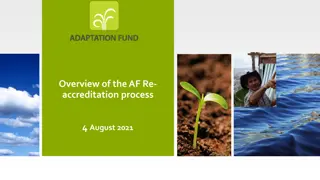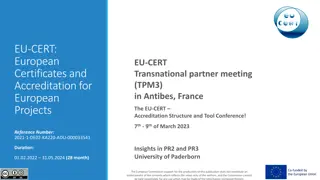
ABET Accreditation and Its Importance in Engineering Education
Discover the significance of ABET accreditation in ensuring the quality of engineering programs and how it benefits graduates in their professional careers. Learn about the objectives, philosophy, and responsibilities associated with ABET accreditation. Find out why it is crucial for engineering programs to maintain high standards and seek ABET certification.
Download Presentation

Please find below an Image/Link to download the presentation.
The content on the website is provided AS IS for your information and personal use only. It may not be sold, licensed, or shared on other websites without obtaining consent from the author. If you encounter any issues during the download, it is possible that the publisher has removed the file from their server.
You are allowed to download the files provided on this website for personal or commercial use, subject to the condition that they are used lawfully. All files are the property of their respective owners.
The content on the website is provided AS IS for your information and personal use only. It may not be sold, licensed, or shared on other websites without obtaining consent from the author.
E N D
Presentation Transcript
1 ABET Accreditation Overview Definitions, Requirements, and Responsibilities Dr. Momen Sughayyer Palestine Polytechnic University Information Meeting College of Engineering, B516, November 1st, 2016 ABET Committee for Engineering Programs April 13, 2025
What is ABET? 2 ABET Accreditation Board for Engineering and Technology It is an organization responsible for monitoring, evaluating, and certifying the quality of engineering, engineering technology, computing, and applied science education in the United States and internationally. It is a federation of leading professional and technical societies representing large number of practicing professionals is indicated fields, such as: ASEE American Society of Engineering Educations ASME American Society of Mechanical Engineering IEEE Institute of Electrical and Electronic Engineering BMES Biomedical Engineering Society ABET-Information Meeting, College of Engineering, B516, 1-11-2016, PPU, PS April 13, 2025
Accreditation Principal Objectives 3 Assure that graduates of an accredited program are adequately prepared to enter and continue the practice of the engineering profession. Stimulate the national/international improvement of engineering education. Encourage new and innovative approaches to engineering education and its assessment. Identify accredited programs to the public and employers. ABET-Information Meeting, College of Engineering, B516, 1-11-2016, PPU, PS April 13, 2025
ABET Philosophy 4 Each Institution and Program define their own mission and objectives to meet the needs of their constituents. Emphasizes outcomes by preparing graduates from the program for entry into professional practice. Programs must demonstrate how their criteria and educational objectives are being met. Programs must design processes leading to continuous program improvement. ABET-Information Meeting, College of Engineering, B516, 1-11-2016, PPU, PS April 13, 2025
Why is ABET accreditation important? 5 ABET helps to assure that the program maintains the high standards through auditing engineering programs on a regular basis (Once every six years). In some countries and for some employers, only graduates from ABET-accredited engineering programs are considered for employment. In some countries, having an engineering degree from an ABET-accredited engineering program is required to become a registered professional engineer. ABET-Information Meeting, College of Engineering, B516, 1-11-2016, PPU, PS April 13, 2025
What the evaluators want to know? 6 How Program Educational Objectives (PEOs) meet the needs of constituencies: Faculty: Full-time lectures and professors of all ranks, they are responsible for working with the other program constituencies to identify appropriate PEOs and to develop the academic program to deliver those objectives. Students: Enrolled students that are the direct beneficiaries of the program. The PEOs are designed to identify the broad skills that they will need to have to be outstanding engineers. Alumni: Program graduates can offer an excellent opportunity to assess the effectiveness of the program through feedback about how their careers and how the program may be altered to improve the preparation of graduates. Employers: The employers of graduates are critical to the success of the program. Their feedback is essential in identifying the characteristics of graduates as outstanding engineers and leaders. ABET-Information Meeting, College of Engineering, B516, 1-11-2016, PPU, PS April 13, 2025
Engineering Accreditation Criteria 7 General Criteria Criterion 1. Students Criterion 2. Program Educational Objectives Criterion 3. Program or Student Outcomes Criterion 4. Continuous Improvement (Assessment) Criterion 5. Curriculum (Professional Component) Criterion 6. Faculty Criterion 7. Facilities Criterion 8. Institutional Support Program Criteria Depending on the program specialty (e.g. Automotives) ABET-Information Meeting, College of Engineering, B516, 1-11-2016, PPU, PS April 13, 2025
C1. Students 8 PPU must evaluate, advise, and monitor students. PPU must have policies for acceptance of transfer students and validation of transfer courses. PPU must have procedures to assure all students meet all program requirements prior to graduation. ABET-Information Meeting, College of Engineering, B516, 1-11-2016, PPU, PS April 13, 2025
C2. Program Educational Objectives 9 Program objectives are what graduates are expected to have achieved within few years after graduation; (three to five years). Each program must have a: detailed and published educational objectives; process based on the needs of constituencies in which the objectives are determined and periodically evaluated; curriculum and process that assure achievement of the objectives; system of on-going evaluation that prove achievement of the objectives; system using evaluation results to improve the effectiveness of the program. ABET-Information Meeting, College of Engineering, B516, 1-11-2016, PPU, PS April 13, 2025
C3. Program Outcomes (a-k) 10 an ability to apply knowledge of mathematics, science, and engineering an ability to design and conduct experiments, as well as to analyze and interpret data an ability to design a system, component, or process to meet desired needs within realistic constraints such as economic, environmental, social, political, ethical, health and safety, manufacturability, and sustainability an ability to function on multidisciplinary teams an ability to identify, formulate, and solve engineering problems an understanding of professional and ethical responsibility an ability to communicate effectively the broad education necessary to understand the impact of engineering solutions in a global, economic, environmental, and societal context a recognition of the need for, and an ability to engage in life-long learning a knowledge of contemporary issues an ability to use the techniques, skills, and modern engineering tools necessary for engineering practice. a) b) c) d) e) f) g) h) i) j) k) ABET-Information Meeting, College of Engineering, B516, 1-11-2016, PPU, PS April 13, 2025
C4. Continuous Improvement Assessment 11 Program outcomes are abilities that students should possess by the time they graduate (Graduation Exit). Programs must demonstrate that the graduates have outcomes a to k; have an assessment process with documented results; provide evidence that the outcomes are being measured; provide evidence that the results of the assessment process are applied to the further development and improvement of the program. ABET-Information Meeting, College of Engineering, B516, 1-11-2016, PPU, PS April 13, 2025
C5. Curriculum Professional Component 12 Prepare enrolled students for professional practice through curriculum to develop a major design experience Base on knowledge and skills from earlier work Incorporating engineering standards and multiple realistic constraints Two semesters (32 hours) of math and basic sciences Three semesters (48 hours) of engineering topics General education component PPU programs need to go out of the box !! ABET-Information Meeting, College of Engineering, B516, 1-11-2016, PPU, PS April 13, 2025
C6. Faculty 13 Faculty should ensure proper guidance of the program and its evaluation, development and improvement. Faculty should be of sufficient number and competencies: to cover all curricular areas; to accommodate adequate levels of student-faculty interaction; for students advising and counseling about: service activities professional development interactions with industrial and employers ABET-Information Meeting, College of Engineering, B516, 1-11-2016, PPU, PS April 13, 2025
C7. Facilities 14 Facilities must be adequate to accomplish program objectives and provide a suitable atmosphere for teaching-learning activities, which should include: Classrooms for lecturing Classrooms with multimedia equipments Laboratories with safe working environment Equipment and Tools to support content Computing and Information Infrastructure for students and faculty activities Certified Technicians and qualified operators Provide opportunities to learn the use of modern engineering tools Infrastructure to support scholarly activities of the students and faculty and the educational objectives of the program. ABET-Information Meeting, College of Engineering, B516, 1-11-2016, PPU, PS April 13, 2025
C8. Institutional Support 15 PPU financial resources and constructive leadership must be adequate to assure quality and continuity of the program. PPU should attract and retain well-qualified and professional faculty. PPU should put in place resource to acquire, maintain and operate equipment and facilities. PPU should provide adequate support administrative staff. PPU should ensure support for quality improvement efforts. ABET-Information Meeting, College of Engineering, B516, 1-11-2016, PPU, PS April 13, 2025
Program Criteria 16 Depending on the program that may also have: Special structure or type criteria Special educational objectives Special outcomes Example: Mechanical Engineering Automotive Branch May have additional program criteria and outcomes in addition to a-k ILOs. ABET-Information Meeting, College of Engineering, B516, 1-11-2016, PPU, PS April 13, 2025
What ABET reviewer is looking for? 17 Comprehensive review of the program: He will examine all aspects to judge compliance with criteria and policies, which assists in recognizing strong and weak points. To accomplish the review, the reviewer will: Interview faculty, students, administrators, and staff to obtain an understanding of program compliance with criteria, policies and specific issues that arise from the Self-Study Report and from the on-site review. Examine the following: Facilities - To assure the instructional and learning environments are adequate and safe for the intended purposes. Materials - Evaluators will review samples of displayed course materials including course syllabi, textbooks, example assignments and exams, and examples of student work, typically ranging from excellent through poor. ABET-Information Meeting, College of Engineering, B516, 1-11-2016, PPU, PS April 13, 2025
What the reviewer is looking for? 18 Examine the following (continue ): Evidence that the program educational objectives stated for each program are based on the needs of the stated program constituencies. Evidence of a documented, systematically utilized, and effective process, involving constituents, for periodic review of the program educational objectives stated for each program. Evidence of the assessment, evaluation, and attainment of student outcomes for each program. Evidence of actions taken to improve the program. Student support services to confirm adequacy of services appropriate to the institution s mission and the program s educational objectives and student outcomes. The process for certifying completion of the program and awarding of the degree, including visits with persons responsible to ascertain that the process works as reported. ABET-Information Meeting, College of Engineering, B516, 1-11-2016, PPU, PS April 13, 2025
Work Responsibilities 19 University Administrative Deanships/Departments Provide resources and leadership required for program quality and continuity by involving: Registration Deanship Student Affaire Deanship Computer Center Human Resources Financial Department Alumni and advisory boards College Deanship Provide support, data, policies etc. Develop College review and improvement process Department Evaluate all assessment input Initiate corrective action Distribute to committees File an annual report Program Faculty: Teachers and technician involved Course objectives, control curriculum Program ABET Committee Input data, corrective action College ABET Committee Provide Guidance, information, forms, training, etc. ABET-Information Meeting, College of Engineering, B516, 1-11-2016, PPU, PS April 13, 2025
What is to be done and who is responsible? 20 No. Activity Responsibility Status 1. University Engineering College vision, mission and goals alignment College Board 2. Program and department vision, mission and goals alignment Department Board 3. Develop Improvement and Assessment Plan for Engineering College College Board 4. College plan for gathering, documenting and reporting input on constituency needs College Board ABET Committee 5. Program plan for gathering, documenting and reporting input on constituency needs Department Board Program Committee 6. Establish Program Educational Objectives Program Committee 7. Establish Student Learning Outcomes for program (ILOs) Program Committee 8. Design curricula structure and the courses to achieve the program educational objectives and the ILOs Program Committee 9. Document the mapping between courses and ILOs Program Committee 10. Prepare syllabi for courses showing how course activities support ILOs Faculty Program Committee ABET-Information Meeting, College of Engineering, B516, 1-11-2016, PPU, PS April 13, 2025
What is to be done and who is responsible? 21 No. Activity Responsibility Status 11. Set the expected students performance levels for ILOs Department Board Program Committee 12. Develop a plan for assessing the program ILOs Department Board Program Committee Faculty 13. Develop a plan for assessing the program educational objectives Department Board Program Committee Faculty 14. Establish College-level performance objectives and indicators College Board 15. Develop assessment plan for college performance objectives College Board ABET Committee 16. Establish program performance objectives and indicators Department Board Program Committee 17. Develop assessment plan for program performance objectives Department Board Program Committee ABET Committee ABET-Information Meeting, College of Engineering, B516, 1-11-2016, PPU, PS April 13, 2025
What is to be done and who is responsible? 22 No. Activity Responsibility Status 18. Establish the program advisory board or oversight group (Faculty and Professionals) College Board Department Board 19. Develop college, department and program improvement process College Board ABET Committee 20. Develop a plan for the documentation of the college level changes and improvements College Board 21. Develop a plan for the documentation of the program changes and improvements Department Board 22. Program Summary Assessment Report Program Committee ABET Committee 23. College assessment plan completed and fully Implemented College Board ABET Committee 24. Preparing Self-Study Report Program Committee ABET Committee ABET-Information Meeting, College of Engineering, B516, 1-11-2016, PPU, PS April 13, 2025

